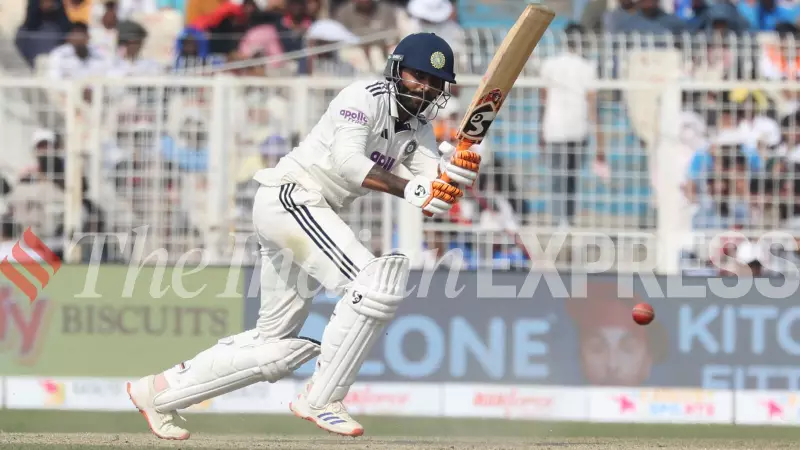
Eden Gardens Pitch Becomes Batting Nightmare for India
The historic Eden Gardens in Kolkata transformed from a cricketing paradise to a batting graveyard as the Indian cricket team suffered a dramatic collapse against South Africa. The much-anticipated Test match turned into a batting horror show that exposed fundamental weaknesses in both skill and temperament among Indian batsmen.
The treacherous pitch conditions played a significant role in the drama, with the surface cracking prematurely and displaying variable bounce throughout the match. However, the real story unfolded in how Indian batsmen responded to these challenging conditions, revealing deeper issues that go beyond just pitch behavior.
Technical Flaws and Poor Shot Selection
Multiple Indian batsmen fell victim to their own questionable decision-making rather than just the pitch's demons. Rishabh Pant's dismissals in both innings highlighted this pattern clearly. In the first innings, he attempted to pull a Marco Jansen bouncer from around the stumps, despite the awkward angle and Jansen's steep bounce. The result was a gloved catch to the wicket-keeper.
Pant's second innings dismissal was equally concerning, as he misread Simon Harmer's flight and offered a simple return catch. What made these dismissals particularly telling was that the pitch had minimal influence on either dismissal - they were products of poor judgment and execution.
Young opener Yashasvi Jaiswal repeated similar mistakes across both innings. Known for his aggressive cutting and slashing against width, Jaiswal persisted with these high-risk shots despite the uneven bounce. His determination to play the cut shot eventually led to his downfall, first edging behind and then falling to a fuller delivery from Jansen.
The Curious Case of Ravindra Jadeja
Perhaps the most telling technical flaw was displayed by Ravindra Jadeja, who fell leg before wicket to Simon Harmer in both innings. Jadeja was guilty of playing with his bat behind the pad against an off-spinner who was consistently getting the ball to straighten into left-handed batsmen.
This recurring mistake highlighted a fundamental technical deficiency that South African bowlers exploited mercilessly. On neither occasion could Jadeja get his front pad out of the ball's line, showing an inability to adapt his technique to the specific challenges posed by Harmer's bowling.
Washington Sundar, despite showing solid defensive technique and smooth footwork, suffered from concentration lapses that proved costly. He was deceived by Harmer's flight and drop in the first innings, falling to a delivery that straightened just enough to take the edge. The pattern repeated in the second innings against Aiden Markram.
Between Attack and Defense: The Dangerous Middle Ground
Former Indian opener Gautam Gambhir provided crucial insight when he observed that the pitch wasn't entirely unplayable. "It might not be a wicket which is going to allow you to be very, very flamboyant, where you can play those big shots. But if you are willing to put your head down, definitely it's a wicket where you can score," Gambhir noted.
This observation pointed to the core issue - Indian batsmen found themselves stuck in what can be called "in-betweenism." They weren't fully committed to either attacking or defensive approaches, resulting in hesitant strokeplay and poor execution.
Dhruv Jurel's dismissal perfectly illustrated this problem. After batting sensibly for a period, he succumbed to temptation against a Harmer short ball. Despite fielders positioned in the deep and the pitch's unpredictable nature making the pull shot particularly risky, Jurel went through with the shot. The ball stopped on him, robbing the shot of its power and resulting in a simple catch in the deep.
Experience vs Execution: Concerning Patterns
What made the batting collapse particularly worrying was that most of the batsmen had substantial Test experience. Apart from Jurel (8 Tests), Axar Patel (15 Tests), and Washington Sundar (16 Tests), every other batsman had accumulated more than 20 Test appearances.
This experience makes the technical and mental errors even more concerning. The problem wasn't inexperience but rather a failure to adapt to challenging conditions and learn from previous mistakes.
The match revealed that when faced with difficult pitch conditions, Indian batsmen suffered from what could be called "bad ball-paranoia" - the fear of unplayable deliveries that weren't necessarily there. This mental state distorted their judgment and led to premeditated shots and defensive uncertainties.
As Gambhir rightly pointed out, the pitch demanded clarity of approach - attackers needed to attack with conviction, while defensive players needed to stonewall resolutely. The Indian batsmen found themselves in the dangerous middle ground, and the result was a comprehensive batting failure that raises serious questions about their ability to handle challenging conditions in crucial matches.





